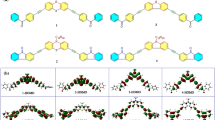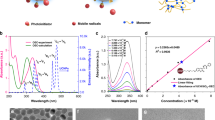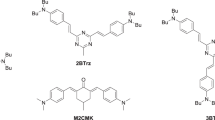Abstract
Two-photon polymerization (TPP) technologies commonly rely on femtosecond lasers such as Ti:sapphire which limits their accessibility due to high costs and complexities. Recently, multiple reports showed TPP under near-infrared irradiation which enables the use of alternative light sources such as Neodymium-doped lasers known to be affordable and efficient for a nanosecond and picosecond pulsed generation. 4,4′-Bis(dimethyl-amino) benzophenone or Michler’s ketone (MK), one of the photoinitiators commonly used for photopolymerization under UV irradiation, also shows an absorption band in the visible region which allows for two-photon polymerization at the fundamental wavelength of Neodymium-doped lasers at 1064 nm. In this report, we investigated the two-photon absorption (TPA) of MK in contrast with Irgacure-784 and Indane-1,3-dione, reported to also be promising photoinitiators for the same TPP process. Among them, MK showed a large TPA cross-section measured via the nonlinear transmission method and Z-scan technique with Q-switched Nd:YAG nanosecond pulse laser at 1064 nm, demonstrating MK as a promising photoinitiator for the low-cost two-photon polymerization.
Similar content being viewed by others
Avoid common mistakes on your manuscript.
1 Introduction
Three-dimensional (3D) printing technologies have been widely used for over a decade because of their usefulness for rapid modeling and prototyping. Recently, photopolymerization techniques have been the focal point of many research efforts, because they enable the high-resolution fabrication of complex structures. Consequently, they have found applications in photonics [1], three-dimensional microfabrication [2], microfluidic [3], and drug delivery [4].
Photopolymerization is a form of radical polymerization that uses light to initiate and propagate a polymerization of a polymer chain. Photopolymers are usually composed of monomers, oligomers, and photoinitiators. Under the irradiation of photons at a specific energy, the photoinitiator will be excited by the irradiation. The excited energy will be passed along with other molecules to initiate the polymerization. The photopolymerization can also be categorized by the types of light sources utilized such as continuous wave [5] or ultrashort pulsed lasers [1,2,3,4, 6, 7]. However, to fabricate sub-micron structures, the two-photon polymerization (TPP) process is required to circumvent the diffraction limit. While photopolymerization relies on the direct absorption of a photon, the TPP, on the other hand, relies on the simultaneous absorption of two photons at a lower energy level, called two-photon absorption (TPA), where the energy of one photon is insufficient to complete the transition between the ground and excited states. Since the simultaneous absorption of two photons rarely occurs in nature, a specific light source that can provide high photon fluxes such as an ultrashort pulse laser is required.
Although sub-micron 3D printings have been demonstrated in the literature, the processes commonly rely heavily on femtosecond lasers such as Ti: Sapphire lasers which increase both complexity and cost, making them less accessible. In contrast, Neodymium lasers (Nd-lasers) are well known as an inexpensive alternative that can provide efficient generation of nanosecond and picosecond pulses. However, most available conventional two-photon photoinitiators have the absorption band in the UV region and not in the visible [8, 9], resulting in them not being suitable for TPA at the Nd-laser fundamental wavelength of 1064 nm. Although there were a few investigations into the two-photon polymerization by the Nd-laser at its fundamental wavelength, a specific combination of photoinitiators and resists [7] or the femtosecond pulses [10] were required. To our knowledge, no attempt has been made to quantify and compare the TPA of commercialized visible-light photoinitiators found in this work under the irradiation of nanosecond pulses provided by Nd-lasers.
To investigate the two-photon absorption of the commercialized visible-light photoinitiators under the irradiation of the Q-switched Nd: YAG nanosecond pulsed laser at 1064 nm similar to [11]. Three visible-light photoinitiators were selected for this study, i.e., 4,4 ‘-bis(dimethyl-amino)-benzophenone (Michler’s ketone: MK) [6], Irgacure-784 (I784) [12, 13], and Indane-1,3-dione (Ind) [14]. Irgacure-784 (I784) is known as a visible-light photoinitiator. The photopolymerization under irradiation at 460 nm was reported in [12]. The photoinitiation mechanism in epoxy resin at 532 nm was presented in [13], making it an excellent candidate for TPA measurement at 1064 nm. In the case of Ind, a combination of Ind and a Zr-based organic–inorganic hybrid material was recently demonstrated as a photoinitiator for the two-photon polymerization under the excitation of picosecond pulses [7]. Though the two-photon polymerization was achieved by a common picosecond laser, a part of the combined photoinitiator was not commercially available on the market and difficult to synthesize. Another success was achieved by combining the 4,4’-bis(dimethyl-amino)-benzophenone with a photoresist (SZ2080) [10]. The polymerization was obtained by an Yb:KGW laser at 1030 nm, still relying on a femtosecond pulsed regime.
In this report, we aim to investigate and quantify the TPA of the commercially available photoinitiators listed above which are suitable for polymerization with Nd-lasers. Linear and nonlinear absorptions were characterized by the UV–Vis spectrophotometer and the Z-scan technique, respectively [15]. Although, both MK and I784 have strong linear absorption at 532, only MK showed an excellent nonlinear absorption at 1064 nm, comparable to other common TPP photoinitiators [16]. With the low-cost Nd: YAG Q-switched nanosecond laser together with MK, the sub-micron 3D printing could be more applicable and affordable.
2 Materials and experiment
4,4’-Bis(dimethyl-amino)-benzophenone (MK), and Indane-1,3-dione (Ind) were purchased from Sigma-Aldrich. Irgacure-784 (I784) was purchased from Shandong Allplace Environmental Protection Technology. All photoinitiators were dissolved in Toluene and ultrasonicated for 30 min at 60 °C. The UV–visible spectrophotometer (Analytik Jena Specord S100) was utilized to examine the linear absorption characteristics for all photoinitiators at 10, 15, 20, and 25 mM concentrations.
Two-photon absorption is a nonlinear process, where two photons are simultaneously absorbed to excite the subject molecule from the ground state to a real excited state [16]. In this work, the nonlinear absorption measurement was carried out by an open-aperture Z-scan technique. The schematic of the experimental setup is shown in Fig. 1. The nanosecond pulses were provided by the Q-switched Nd: YAG nanosecond laser (CNI: MPL-FL-1064) with a 10 Hz repetition rate, 13 ns pulse duration, and 46 mW average power. The laser pulses were focused and then collected by the convex lenses L1 and L2, respectively. The focal spot size is 45 \(\mathrm{\mu m}\) in radius. The sample was placed at the center between the two lenses and moved along the optical axis (z-axis). The transmitted power was monitored by the power detector D (Gentec-e Power detector, UP19K-30H-H5-D0). The two-photon absorption can be observed as a drop in the transmission (Fig. 4).
The normalized transmission through a nonlinear medium (\(T(z)\)) can be written as [15]
where \({q}_{0}=\beta {L}_{\mathrm{eff}}{I}_{0}\),\({z}_{R}\) is the Rayleigh length, \(\alpha\) is the absorption coefficient, and \({L}_{\mathrm{eff}}=\left(1-{e}^{-\alpha L}\right)/\alpha\) is the effective length of the sample. For the transparent sample, \({L}_{\mathrm{eff}}\approx L\). The parameters for the z-scan measurement are shown in Table 1.
The two-photon absorption coefficient (\(\beta\)) can be extracted by fitting the result with Eq. (1). The two-photon absorption cross-section (\({\sigma }_{\mathrm{TPA}}\)) describes the efficiency of this process to occur in a particular material [17]. It can be defined as
where \(\mathrm{\hslash \omega }\) is the energy of the absorbed photon, \({N}_{A}\) is Avogadro’s number, and \(\mathrm{C}\) is the concentration in moles per liter. The two-photons absorption cross-section \(({\sigma }_{\mathrm{TPA}})\) can be obtained from (2).
3 Results and discussion
Among the three chosen photoinitiators, i.e., MK, I784, and Ind, all reported that they can either be used to initiate the one-photon polymerization at 532 nm or two-photon polymerization with near-infrared ultrashort pulses [6, 10, 13, 14], and only I784 and MK showed linear absorbance at 532 nm, while Ind does not show detectable absorption at the same wavelength (Fig. 2). The absorbance of I784 was very strong below the wavelength 550 nm. Beyond this wavelength, there was no absorption observed. On the other hand, MK showed strong absorbance below 400 nm. However, a broad weak absorption band was observed around the wavelengths 500–700 nm. Figure 3 shows the absorbance of the three photoinitiators as a function of the concentration. While the absorption spectra at 532 nm were increased with the concentrations, the absorption at 1064 nm was measured and remained unchanged.
The nonlinear absorption was characterized by the Z-scan technique. The experiment was carried on by the Nd: YAG nanosecond laser at 1064 nm with 10 Hz. Although both I784 and MK exhibited absorption at 532 nm, only the nonlinear absorption of MK was observed (Fig. 4).
Figure 5 shows the effect of MK’s concentration on the nonlinear absorption. While the concentrations of the photoinitiators were increased, the change in the transmission at the center (z = 0) has been significantly increased. In Fig. 6, TPA coefficients were plotted as a function of the initiator’s concentration. TPA cross-section was calculated by (2), to be \(587 \times {10}^{-50}\mathrm{ c}{\mathrm{m}}^{4}\bullet \mathrm{s}\bullet {\mathrm{photon}}^{-1}.\) In the case of Ind, though it was successfully used as a combination [7], the nonlinear absorption was not observed by our current experiment. Moreover, it showed neither linear nor nonlinear absorptions, suggesting that it is not suitable as a standalone photoinitiator for photopolymerization with Nd-lasers.
Open-aperture Z-scan results of Michler’s ketone at different concentrations, i.e., 2.5 mM (circle), 5 mM (triangle), 10 mM (inverted triangle), 15 mM (asterisk), 20 mM (star), and 25 mM (square), under nanosecond pulses’ irradiation at 1064 nm. The error bars showed the standard error of the mean. The solid lines showed the theoretical fit by Eq. (1)
Despite the strong linear absorption of I784 at 532 nm compared to MK, a strong TPA of I784 at 1064 nm was not observed under the current setup. However, this could be caused by the limitation of our experiment. Since a very small change in the transmission cannot be accurately measured due to the noise level, measuring the TPA cross-section < 10 GM undetectable with the current setup.
It is worth noting that the TPA cross-section of MK at 1064 nm is very large and comparable to those of common TPP photoinitiators at their peak absorption wavelengths [16]. Although MK is known as a solvatochromic compound, i.e., solvent-dependent absorption compound, the previous study mentioned that the UV/Vis absorption of MK is very stable in different solvents [18]. Nevertheless, in our work, although the stability of the dyes in different solutions has not been explored, The UV/Vis absorption of MK in Toluene and MMA were compared (Fig. S1). Both MK/Toluene and MK/MMA showed a similar absorption spectrum. Moreover, the fact that we obtained the large TPA cross-section with the nanosecond pulse at low repetition rates (10 Hz) indicated that MK could be a very promising photoinitiator for the two-photon polymerization by nanosecond lasers at a low repetition rate.
4 Conclusion
Most of the two-photon polymerization technologies have relied on Ti:Sapphire femtosecond lasers, limiting the accessibility significantly due to the overall cost and complexity of the setup. Since MK showed absorption at the wavelength of 532 nm, it is one of the promising photoinitiators for two-photon polymerization at the wavelength of 1064 nm. In this report, we measured the two-photon absorption of MK and the other two commercialized photoinitiators under the excitation of the Nd:YAG nanosecond laser at 1064 nm. MK was the only one that exhibited nonlinear absorption. The two-photon absorption cross-section of MK is \(587\times {10}^{-50}{\mathrm{cm}}^{4}\bullet \mathrm{s}\bullet {\mathrm{photon}}^{-1}\), which is high compared to common photoinitiators. As MK exhibited an excellent TPA, it is promising to use it as an initiator for the sub-micron structuring by a low-cost and low repetition rate such as a q-switched laser. Although TPA was not observed for both I784 and Ind, we can set the upper limit for TPA cross-section to less than \(10\times {10}^{-50}{\mathrm{cm}}^{4}\bullet \mathrm{s}\bullet {\mathrm{photon}}^{-1}\) for both. For future work, even though MK exhibits a high TPA cross-section as reported here, other factors that contribute to polymerization, such as additives, thermal accumulation, and the repetition rate of a pulsed laser, also play important roles; therefore, further investigation is needed to optimize TPP for each application.
References
T. Andrea, D. Johannes, T. Simon, G. Harald, H. Alois, Light: Adv. Manuf. 2, 20–30 (2021). https://doi.org/10.37188/lam.2021.002
D. Yang, L. Liu, Q. Gong, Y. Li, Macromol. Rapid Commun. 40, 1900041 (2019). https://doi.org/10.1002/marc.201900041
A. Urrios, C. Parra-Cabrera, N. Bhattacharjee, A.M. Gonzalez-Suarez, L.G. Rigat-Brugarolas, U. Nallapatti, J. Samitier, C.A. DeForest, F. Posas, J.L. Garcia-Cordero, A. Folch, Lab Chip 16, 2287–2294 (2016). https://doi.org/10.1039/c6lc00153j
J.F. Xing, M.L. Zheng, X.M. Duan, Chem. Soc. Rev. 44, 5031–5039 (2015). https://doi.org/10.1039/c5cs00278h
X.X. Shen, X.Q. Yu, X.L. Yang, L.Z. Cai, Y.R. Wang, G.Y. Dong, X.F. Meng, X.F. Xu, J. Opt. A: Pure Appl. Opt. 8, 672–676 (2006). https://doi.org/10.1088/1464-4258/8/8/008
E. Stankevičius, E. Daugnoraitė, A. Selskis, S. Juodkazis, G. Račiukaitis, Opt. Express 25, 4819–4830 (2017). https://doi.org/10.1364/OE.25.004819
D. Perevoznik, R. Nazir, R. Kiyan, K. Kurselis, B. Koszarna, D.T. Gryko, B.N. Chichkov, Opt. Express 27, 25119–25125 (2019). https://doi.org/10.1364/OE.27.025119
B.H. Cumpston, S.P. Ananthavel, S. Barlow, D.L. Dyer, J.E. Ehrlich, L.L. Erskine, A.A. Heikal, S.M. Kuebler, I.Y.S. Lee, D. McCord-Maughon, J. Qin, H. Röckel, M. Rumi, X.-L. Wu, S.R. Marder, J.W. Perry, Nature 398, 51–54 (1999). https://doi.org/10.1038/17989
K.-S. Lee, D.-Y. Yang, S.H. Park, R.H. Kim, Polym. Adv. Technol. 17, 72–82 (2006). https://doi.org/10.1002/pat.664
M. Malinauskas, A. Žukauskas, G. Bičkauskaitė, R. Gadonas, S. Juodkazis, Opt. Express 18, 10209–10221 (2010). https://doi.org/10.1364/OE.18.010209
T. Olivier, F. Billard, H. Akhouayri, Opt. Express 12, 1377–1382 (2004). https://doi.org/10.1364/OPEX.12.001377
M. Degirmenci, A. Onen, Y. Yagci, S.P. Pappas, Polym. Bull. 46, 443–449 (2001). https://doi.org/10.1007/s002890170030
D. Sabol, M.R. Gleeson, S. Liu, J.T. Sheridan, J. Appl. Phys. 107, 053113 (2010). https://doi.org/10.1063/1.3276173
F. Dumur, Eur. Polymer J. 143, 110178 (2021). https://doi.org/10.1016/j.eurpolymj.2020.110178
M. Sheik-Bahae, A.A. Said, T. Wei, D.J. Hagan, E.W.V. Stryland, IEEE J. Quantum Electron. 26, 760–769 (1990). https://doi.org/10.1109/3.53394
K.J. Schafer, J.M. Hales, M. Balu, K.D. Belfield, E.W. Van Stryland, D.J. Hagan, J. Photochem. Photobiol. A 162, 497–502 (2004). https://doi.org/10.1016/S1010-6030(03)00394-0
A. Ajami, W. Husinsky, R. Liska, N. Pucher, J. Opt. Soc. Am. B 27, 2290–2297 (2010). https://doi.org/10.1364/JOSAB.27.002290
Y. Wen, X. Jiang, J. Yin, Prog. Org. Coat. 66(1), 65–72 (2009). https://doi.org/10.1016/j.porgcoat.2009.06.003
Acknowledgements
This research project is supported by Mahidol University (Basic Research Fund: fiscal year 2021).
Author information
Authors and Affiliations
Contributions
Suwat Romphosri wrote the main manuscript text and prepared the figures. Phyu Sin Oo wrote a certain small portion of the manuscript. Suwat Romphosri, Pornpawee Karanyasopon, Rakchart Traiphhol, Tanant Waritanant, helped with the ideation and methodology. All authors reviewed the manuscript.
Corresponding author
Ethics declarations
Competing interests
The authors declare no competing interests.
Additional information
Publisher's Note
Springer Nature remains neutral with regard to jurisdictional claims in published maps and institutional affiliations.
Supplementary Information
Below is the link to the electronic supplementary material.
Rights and permissions
Springer Nature or its licensor holds exclusive rights to this article under a publishing agreement with the author(s) or other rightsholder(s); author self-archiving of the accepted manuscript version of this article is solely governed by the terms of such publishing agreement and applicable law.
About this article
Cite this article
Romphosri, S., Oo, P.S., Karanyasopon, P. et al. Two-photon absorption cross-section investigation of visible-light photoinitiators under Q-switched Nd:YAG nanosecond pulse laser at 1064 nm. Appl. Phys. B 128, 164 (2022). https://doi.org/10.1007/s00340-022-07888-7
Received:
Accepted:
Published:
DOI: https://doi.org/10.1007/s00340-022-07888-7










